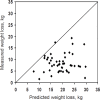Influence of changes in body composition and adaptive thermogenesis on the difference between measured and predicted weight loss in obese women
- PMID: 20054213
- PMCID: PMC6444599
- DOI: 10.1159/000210369
Influence of changes in body composition and adaptive thermogenesis on the difference between measured and predicted weight loss in obese women
Abstract
Background: There is a difference between measured and predicted weight loss in obese patients. This might be explained by the composition of weight loss, adaptive thermogenesis, or poor compliance.
Patients and methods: 48 overweight and obese female patients (31.5 +/- 6.1 years; BMI 35.4 +/- 4.4 kg/m(2)) were investigated before and 13.9 +/- 2.4 weeks after dietary treatment (1,000 kcal/day). Body composition was measured by air-displacement plethysmography and resting energy expenditure (REE) by indirect calorimetry. Physical activity was assessed using electronic pedometers in order to calculate total energy expenditure from REE and physical activity level (PAL). Fat mass (FM) and fat-free mass (FFM) were converted into caloric equivalents using 9.45 kcal/g FM and 1.13 kcal/g FFM. Predicted weight loss was calculated by Wishnofsky's '7,700 kcal/kg rule'.
Results: Weight (-8.4 +/- 3.9 kg; p < 0.001), FM (-7.8 +/- 3.6 kg; p < 0.001), and FFM (-0.6 +/- 2.0 kg; p < 0.05) decreased with caloric restriction. Measured weight loss was only 44% of the predicted value. Since FM contributed to 87% of weight loss, the energy deficit/kg weight loss was considerably higher (9,098 +/- 2,349 kcal/kg) than the assumed 7,700 kcal/kg. Adaptive thermogenesis after weight loss was significant in 26 of 48 women (-3.2 +/- 1.2 kcal per kg FFM; p < 0.001).
Conclusion: 14% of the difference between measured and predicted weight loss was explained by the higher proportion of FM in weight loss and 38% by adaptive thermogenesis (in 54% of the women). Thus, poor compliance was responsible for about 50% of the difference between measured and predicted weight loss only.
2009 S. Karger AG, Basel.
Figures


Similar articles
-
Does metabolic compensation explain the majority of less-than-expected weight loss in obese adults during a short-term severe diet and exercise intervention?Int J Obes (Lond). 2012 Nov;36(11):1472-8. doi: 10.1038/ijo.2012.109. Epub 2012 Jul 24. Int J Obes (Lond). 2012. PMID: 22825659
-
Changes in thoracic gas volume with air-displacement plethysmography after a weight loss program in overweight and obese women.Eur J Clin Nutr. 2008 Mar;62(3):444-50. doi: 10.1038/sj.ejcn.1602709. Epub 2007 Mar 28. Eur J Clin Nutr. 2008. PMID: 17392701
-
Contribution of individual organ mass loss to weight loss-associated decline in resting energy expenditure.Am J Clin Nutr. 2009 Oct;90(4):993-1001. doi: 10.3945/ajcn.2008.27402. Epub 2009 Aug 26. Am J Clin Nutr. 2009. PMID: 19710198 Clinical Trial.
-
Changes in Energy Expenditure with Weight Gain and Weight Loss in Humans.Curr Obes Rep. 2016 Dec;5(4):413-423. doi: 10.1007/s13679-016-0237-4. Curr Obes Rep. 2016. PMID: 27739007 Free PMC article. Review.
-
Adaptive thermogenesis with weight loss in humans.Obesity (Silver Spring). 2013 Feb;21(2):218-28. doi: 10.1002/oby.20027. Obesity (Silver Spring). 2013. PMID: 23404923 Review.
Cited by
-
Yoyo Dieting, Post-Obesity Weight Loss, and Their Relationship with Gut Health.Nutrients. 2024 Sep 19;16(18):3170. doi: 10.3390/nu16183170. Nutrients. 2024. PMID: 39339770 Free PMC article. Review.
-
Revisiting Resting Metabolic Rate: What is the Relation to Weight Fluctuations?Curr Obes Rep. 2023 Dec;12(4):502-513. doi: 10.1007/s13679-023-00528-x. Epub 2023 Sep 27. Curr Obes Rep. 2023. PMID: 37755607 Review.
-
Branched Chain Amino Acid Supplementation to a Hypocaloric Diet Does Not Affect Resting Metabolic Rate but Increases Postprandial Fat Oxidation Response in Overweight and Obese Adults after Weight Loss Intervention.Nutrients. 2021 Nov 26;13(12):4245. doi: 10.3390/nu13124245. Nutrients. 2021. PMID: 34959797 Free PMC article. Clinical Trial.
-
Impact of Protein Intake during Weight Loss on Preservation of Fat-Free Mass, Resting Energy Expenditure, and Physical Function in Overweight Postmenopausal Women: A Randomized Controlled Trial.Obes Facts. 2021;14(3):259-270. doi: 10.1159/000514427. Epub 2021 May 11. Obes Facts. 2021. PMID: 33975325 Free PMC article. Clinical Trial.
-
The usefulness of an accelerometer for monitoring total energy expenditure and its clinical application for predicting body weight changes in type 2 diabetic korean women.Korean Diabetes J. 2010 Dec;34(6):374-83. doi: 10.4093/kdj.2010.34.6.374. Epub 2010 Dec 31. Korean Diabetes J. 2010. PMID: 21246011 Free PMC article.
References
-
- Wishnofsky M. Caloric equivalents of gained or lost weight. Am J Clin Nutr. 1958;6:542–546. - PubMed
-
- Chaston TB, Dixon JB, O'Brien PE. Changes in fat-free mass during significant weight loss a systematic review. Int J Obes (Lond) 2007;31:743–750. - PubMed
-
- Krieger JW, Sitren HS, Daniels MJ, Langkamp-Henken B. Effects of variation in protein and carbohydrate intake on body mass and composition during energy restriction a meta-regression 1. Am J Clin Nutr. 2006;83:260–274. - PubMed
-
- Heymsfield SB, Harp JB, Reitman ML, Beetsch JW, Schoeller DA, Erondu N, Pietrobelli A. Why do obese patients not lose more weight when treated with low-calorie diets? A mechanistic perspective. Am J Clin Nutr. 2007;85:346–354. - PubMed
-
- Major GC, Doucet E, Trayhurn P, Astrup A, Tremblay A. Clinical significance of adaptive thermogenesis. Int J Obes (Lond) 2007;31:204–212. - PubMed

